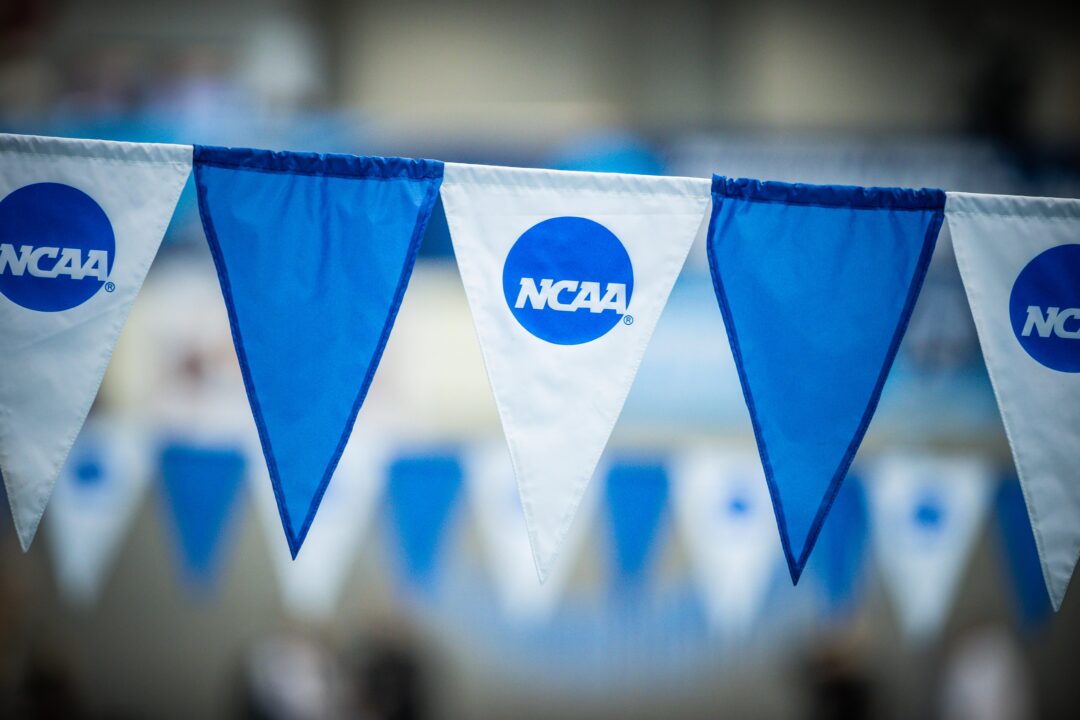The NCAA Swimming and Diving Rules Committee has proposed a number of rules changes for the 2023-2024 academic year, including a clearer definition of what should be considered a bona fide competition in the sport.
Bona fide competition rules have frequently been a topic of controversy in swimming given the varying and overlapping nature of competitions. That includes in 2018, when a pair of would-be NCAA Championship qualifiers weren’t selected because their Last Chance meet had no other men’s teams, thereby not satisfying the rules requiring multiple teams to be present for a meet to be bona fide.
The Committee, which met last week in Indianapolis, recommended eliminating noncollegiate athletes from participating in an official program of collegiate meets. However, noncollegiate athletes would be allowed to compete in exhibition events conducted outside the meet program.
It’s not clear how this would impact meets like the Short Course World Championships or US National Championships (when held in yards) that have, in the past, been allowed as NCAA Championship qualifying meets. The rule seems, more explicitly, to address post-graduate swimmers racing in collegiate meets.
According to the current NCAA rules book Rule 9, bona fide competition must meet the following criteria:
a. Meet is open to the public (spectators);
b. Competition is between two or more teams of the same gender at the same time and site, from different collegiate institutions;
c. All NCAA competitors must be eligible by NCAA standards;
d. Meets must be in institutions’ approved competition schedule;
e. Meets must have published results; and
f. Depending on the governing body, meet official(s) must be qualified and/or certified.
Or
g. Any bona fide meet as defined above and that is sanctioned or approved by USA Swimming and USA Diving that follows NCAA rules and regulations.
h. Select USA Swimming and USA Diving meets which are acceptable for achievemnet [sic] of time standards, consideration standards and optional entry standards may be designated each year by the NCAA Swimming and Diving Championship Committee.
Any attempt to circumvent the intent or rules of bona fide competition is considered a serious ethical violation under NCAA rules and area subject to “severe penalty to both the competitor(s) and the institution(s) involved.”
While the committee
“We want to create an experience that honors collegiate athletes competing in a collegiate environment, but still recognizing that the sport can be exciting and fun for others,” said Jessen Book, chair of the rules committee and men’s and women’s swimming coach at Kenyon. “We want there to be a clear way to do both.”
Other Proposed Rules Changes
- Adding a definition for an optional team diving event, which many D1 conferences experimented with at 2023 conference championship meets. Under this format, a team would consist of three divers from the same school. Each diver would complete two dives of the prescribed six dive list, which would include one dive from every group (front, back, reverse, inward, twist and armstand). The event would include multiple disciplines, either two from 1-meter, 3-meter, and platform, or three each from the 1-meter and 3-meter springboards. The event would be a scored final with no preliminary round.
- “This is about creating opportunities,” Book said. “So, we look for places where we can make the sport better. It is not a mandate that teams must do this event. It is an option just like the 50-yard freestyle or the 100-yard individual medley events are.”
- The committee approved an experimental rule for next season that allows coaches to review video after the 30-minute protest time expires. The meet committee may provide access to the video review for a coach to view, and it can only be used for educational purposes.
- The committee recommended an optional rule to allow the use of underwater cameras for video review to confirm disqualification for swimming infractions.
- The use of tape, kinesiology tape and compression sleeves would be permitted to treat a documented medical condition. Documentation from a physician or certified athletic trainer to use tape, kinesiology tape or compression sleeves would be presented to the referee. The prescribed course of treatment would set forth a minimally invasive taping plan to support the athlete’s medical condition. If this rule were to differ from USA Swimming’s rules on those items, it would create one of the rare gaps between NCAA and USA Swimming rules.
- Ties would be allowed to be decided by a method other than a swim-off, such as a coin toss, if agreed upon by both coaches. If there is no agreement, a swim-off would be held. In USA Swimming competition, any number of unusual tiebreakers have been used, including a game of Rock, Paper, Scissors.
- The committee refined the language regarding swimwear for swimmers and divers, identifying swimwear standards as well as logo specification for swim caps.
All rule proposals must be approved by the NCAA Playing Rules Oversight Panel before becoming official. The swimming and diving recommendations for the 2023-24 academic year are scheduled to be discussed by the panel July 19.
While the NCAA published a press release about the rules changes, they have declined to proved the actual text of the proposed changes.

I wonder what the rules are when varsity collegiate programs include club programs.
I swam club and competed in some college varsity meets. NAIA and D3.
I am amazed that such important changes have such an air of opacity!
Where is the transparent discussion of these important issues?
NO actual text? That alone is simply not acceptable.